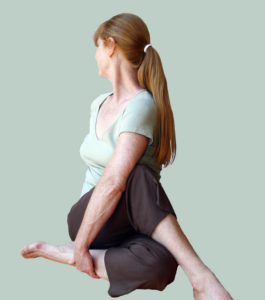Spring cleaning: it’s not just for houses.
I don’t know about you, but when spring rolls around I often feel all kinds of clogged up and sticky from my winter hibernation. This feeling usually means there’s a bunch of junk stored up in my body that needs to get the heck out!
If you feel sluggish or tired all the time, spring may be a good time to consider some internal cleansing — and what better time than when the weather is starting to warm up and your natural tendency is to get more active!
While you may be aware that you can detox through what you eat and drink, did you know you can also help your body to naturally detoxify through breath and movement?
Let’s take a look at three potent practices that will help you support your body’s natural detoxification processes.
1. Kapalabhati (Skull Shining Breath)
Unlike some of the gentle breathing practices we’ve covered in this 3 Practices series, Kapalabhati is pretty intense. It really gets the oxygen flowing through your veins, stimulates the digestive organs, and can even help clear up sinus congestion. (Keep some tissues handy when you’re doing this one.)

How to do it:
Kapalabhati is rapid abdominal breathing. The exhalation is forceful, and the inhale that follows is automatic.
It may be helpful to place your right hand on your lower abdomen, so you can feel the muscles contract in toward the spine.
Step 1: Sit up comfortably, with a long neutral spine. To exhale, snap in (aka quickly contract) the abdomen. This will push air out through the nostrils.
Step 2: Relax the abdomen, and allow the inhalation to occur naturally. (You won’t have to actively draw breath back in to the lungs.)
Step 3: Continue this pattern of forceful contraction of the abdomen and relaxation for a total of 10 breaths. Aim for one exhalation per second if you’re new to this pranayama practice.
Step 4: Exhale completely, pulling the abdomen in. Then inhale a full, 3-part breath.
Step 5: Return the breath to a normal pattern, and observe how you feel. Can you sense the extra oxygen starting to circulate through your system? You may feel slightly tingly or more alert.
Step 6 [optional]: You may want to repeat this cycle two more times, for a total of 3 cycles of 10 breaths each. Start with short sessions, and work your way up as you get more comfortable with the practice.
By pulling lots of oxygen-rich air into your lungs, you end up circulating extra oxygen into the blood stream. And all that oxygen helps your body not only efficiently absorb vitamins, but also boosts white blood cell production.
You can find more info here.
Health note: if you ever feel dizzy or lightheaded, stop immediately and return your breath to normal. And you may want to be especially careful to give yourself enough time after you eat to do this one — intense contractions of the lower abdominal muscles plus a full stomach may equal disaster. Just sayin’…
2. Karana Mudra (Instrument Gesture)
In Sanskrit, karana means “instrument” — not like a guitar or saxophone, but rather a tool that we use to help us complete a particular action. In this case, the mudra itself is an instrument that we can use to help purify the physical body.
In plain English, it helps us to detoxify by strengthening both the urinary and kidney energy lines in the body.

This particular mudra reminds me of the “rock on” gesture, and a little bit of that heavy metal intensity could be called for, depending on how much crap you feel like you need to clear out.
How to do it:
You can practice this mudra any way that’s comfortable — sitting, standing, laying down. This mudra is practiced with only the right hand, so keep your left hand gently unengaged somewhere that’s comfortable.
Bend the middle and ring fingers of your right hand down toward your palm, and press down on both fingernails with the pad of your right thumb. Allow the index and pinky fingers to remain extended, and slightly relaxed. Hold this gesture for as long as feels comfortable.
For more information, take a look at this mudra in the book Mudras for Modern Life.
3. Ardha Matsyendrasana (Half Spinal Twist)
Twists are one of the best ways to detoxify the body. By bringing gentle compression to the internal organs, you begin to squeeze out old blood and lymph — and when you release the twist, the resulting flow of freshly oxygenated blood back into the cells flushes out anything that’s been loosened up.
Your lymphatic system is one of the main drainage systems that helps your body get rid of all the stuff it doesn’t want anymore — dead cells, unused nutrients and plasma, and toxins. And most of our circulatory systems come with a built-in pump. The heart circulates blood, the lungs circulate oxygen, the digestive system pushes food through…
But the lymphatic system doesn’t have a pump. It relies on you to keep the lymph moving through. That’s where practices like dry brushing, deep breathing, and legs up the wall come in — as well as bendy, twisty yoga poses.
While any twists that you might take will be beneficial, Ardha Matsyendrasana is particularly good for you because it also brings compression into the lymph nodes that are located in the area at the front of the hips.
How to do it:
Find a comfortable seated posture with your legs stretched out in front of you. It can be helpful to sit up on the edge of a blanket, especially if you have tight hips or hamstrings.

Draw your right knee in toward your chest, with the sole of the foot on the floor next to your outstretched left leg. Then step the right foot across your left leg.
Either take hold of the base of the right knee with your left hand, or wrap the crease of the left elbow around the raised knee, to bring yourself into the twist. Place the right hand behind your back, and turn the gaze gently over the right shoulder.
You can either leave the left leg outstretched, or draw it back toward the hip (as pictured here).
Breathe deeply, imagining drawing the breath up and down the length of the spine — from the base of the spine up to the top of the head on the inhale, and allowing the exhale to release back down the length of the spine. Stay here for at least a few breaths, or as long as the twist feels comfortable.
To release out of the pose, bring the gaze back to center and then release the left arm. Untwist, and consider taking a counter-twist in the opposite direction to release the spine.
Then repeat on the opposite side.
This pose helps to balance not only the digestive and lymphatic systems, but also the immune, nervous, muscular, and skeletal systems. It’s balancing for all three Ayurvedic doshas (Vata, Pitta, and Kapha), and activates all five of the elements in the body (earth, water, fire, air, and ether).
Health note: it’s good to remember that detoxification may make you feel worse before you feel better. As your body is processing and getting rid of all the stuff you’re moving out, you may feel a little gross — these reactions vary from person to person.
But if you stay well hydrated and make sure to get enough rest, you’ll be back to feeling great before you know it. And you might even feel better than you have in a long time!
Let that shit go…
While January 1st may be the traditional start to our new year, the spring season is really when a lot of folks get motivated to make changes, to declare “out with the old, in with the new” — and your desire to detox may be no different.
By implementing the practices in this post, you’ll be well on your way to supporting your body systems as they do just what they’re meant to do.
So take one (or all three) of these practices and give your body a break. You deserve it!
Want to put “detox through movement” into practice? Join my online yoga mailing list and you’ll be the first to hear about new yoga classes and workshops.

This looks very interesting but challenging for the body. I hope I have the flexibility to execute it.